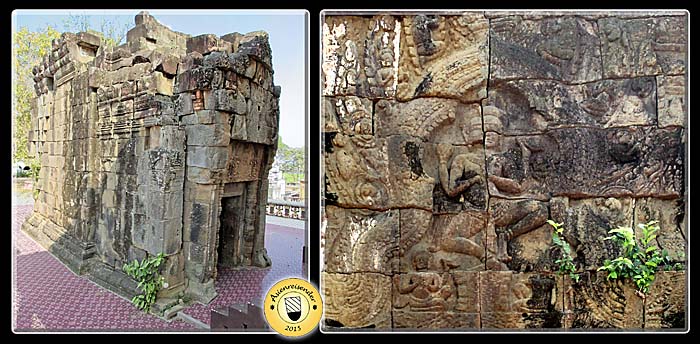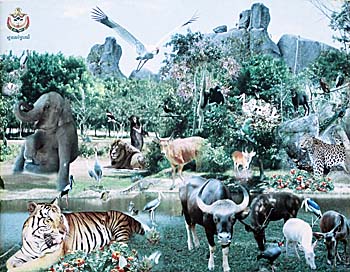
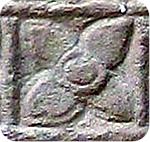
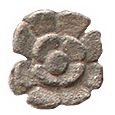
1.
Ta Prohm
Very surprisingly the visit to the Angkorian site of Ta Prohm turned out to be a fine discovery. It is a middle-sized temple compound with a number of well-preserved reliefs in the walls, of whom some tell small stories. They are unique in their kind.
Ta Prohm is placed on a site of an older sanctuary of the sixth century. It was built in the reign of Jayavarman VII (1181 until either 1206 or 1220 CE), who is considered the most significant and powerful Angkorian godking (devaraja). Jayavarman VII also ordered the construction of a new Angkorian capital, Angkor Thom, after the old capital was occupied for several years by Angkor's eastern rival, the Champa empire.
Ta Prohm, Main Sanctuary
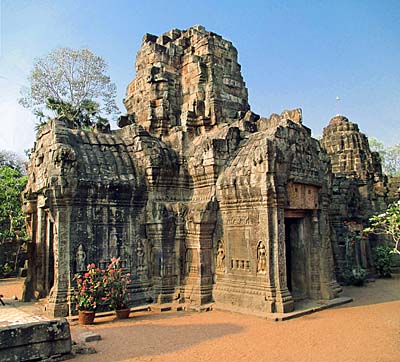
The central sanctuary of Ta Prohm, built in fine sandstone, with a lot of well preserved fresquos. Image by Asienreisender, 2/2015
Although Jayavarman VII converted from hinduism to mahayana buddhism, the temple of Ta Prohm is dedicated to Shiva, the main hindu god. Nevertheless there are also Buddha motives engraved, particularly in the lintel above the entrance to the central sanctuary, where a reclining Buddha is put. I am not sure about the age of the reclining Buddha, for it looks stylistic clearly different to the other carvings and it wouldn't surprise me if it is of a younger age. Besides it is the only relief which is partially coloured. In the past all the now ancient temples have been coloured, particularly the fresquos; nowadays we always merely see the blank stone.
The temple compound is aligned to an east-west axis and consists of five sanctuaries plus two libraries. The five sanctuaries are shaped into the form of a crucifix. The main sanctuary is built in sandstone, the finest material, while the other buildings and the walls are built in laterite stone. There is an inner wall uniting the five sanctuaries and the whole compound is surrounded by an outer wall in a distance of some 50 meters. The outer wall has an entrance at the east and an exit westwards.
Inside the main sanctuary is a large, standing Buddha. Behind this main Buddha is another, smaller Buddha placed, also in a standing position. The other sanctuaries house several other artefacts like lingas and broken statues. Partially the statues are wrapped in cloths; incence and flowers are part of the composition. The usual, unproportional big donation boxes are not to overlook.
In the northern sanctuary stood originally a statue of Preah Noreay, a hindu goddess which has the power to grant fertility over childless women, as it is believed. The statue has been removed and is now in the National Museum of Phnom Penh.
Map of Ta Prohm Inner Temple Compound

A map of the inner temple compound of Ta Prohm. This inner site is surrounded by another laterite wall in a certain distance of roughly 50m. Now it's partially bare ground or trees and bushes are growing there; in the past, there is no doubt, it was used for other purposes. A few, very basic stone remains indicate that.
Khmer Scrolls

There is unfortunately nothing at all left of all the medieval Khmer scrolls who were stored in the libraries as the two here at Ta Prohm. All the written witnesses of the Angkorian empire has been fallen victim to humidity, fire and termits. The only surviving text of Angkor is from Zhou Daguan, who was accompanying an Chinese envoy in 1296 CE to Angkor Thom.
The scrolls on the image are in the Buddha Footprint Pavilion in the Royal Palace of Phnom Penh. Image by Asienreisender, 12/2014
The sight of Ta Prohm can be reached from Phnom Penh via national road 2 or from Takeo on the same road. Coming from Phnom Penh there is a huge sign at a not paved side road right hand at a bigger Sokimex petrol station. Coming from Takeo (45km distance) the sign is not to see and the only point of orientation is the petrol station.
In the past there was an entry fee for the whole place, including the lakeshore of nearby Tonle Bati with the restaurant huts (see below). Now there was, surprisingly, nobody charging. Personally I spent two days at the site and met merely one group of other tourists, apparently from Singapore. Although it's such an attractive sight and merely 35km from Phnom Penh, few visitors come here.
There is much begging at the place. Some elder women live there and keep the place a bit clean; they are dressed as buddhist nuns. Additionally some kids are around, selling flowers to tourists. They say they would need the money urgently for attending school.
One has to keep in mind that there is no guesthouse or any other place to stay for a night at Tonle Bati. The next accommodation is rather in the outskirts of Phnom Penh or, in the other direction, in Takeo.
Ta Prohm Temple Compound & Fresquos
The Temple of Ta Prohm
The eastern front of the main compound was the entrance to the site (1). Striding through the main gate with the prasat (tower) on top, one enters the inner court, facing the main sanctuary. This inner court (2) is surrounded by a wall with a gangway inside. There are two libraries placed at each side south and north, close to the entrance. Image 3 shows the northern library.
The entrance to the main sanctuary (4) is over and over engraved with filigree carvings, showing apsaras, blossoms, daemons in different variations.
A carving at the northeastern corner of the main sanctuary (5) shows a woman carrying a big bag on her head, which allegedly contains the afterbirth of her recent pregnancy. She has been respectless against the midwife, who doomed her to carry the basket for the rest of her life. The midwife is displayed much larger than the mother; in front of her is the kneeling husband of the wife shown, begging for forgiveness. The husband is unproportional small and holds his hands folded in a prayerlike position. Might be that the midwifes in the old times were personalities of religious significance. You have to look carefully to recognize the three persons - the woman is left, dark coloured, the midwife in the middle and the man right hand.

At the northwestern corner of the main sanctuary is a king sitting above one of his wives under an umbrella (6). The wife is blamed having betrayed the king. She has been sentenced to be trampled to death by a horse as shown.
The main sanctuary has three entrance gates, all richly engraved. One has to climb a bit to gain a view on the carvings above the southern gate (7).
A few large panels are placed on the ground at the entrance area of the compound (8 - 11). In the past there was by all means more stuff placed within and outside the inner compound.
Image 12 shows the southern entrace to the main sanctuary. The lintel above the door is clearly a work of recent restoration. Interestingly, the medieval Khmer architects didn't learn the technique of the arc stone, building a stabile arc. Inside the building are two Buddhas, both in a standing position. This one (13) is the one in the central crossway.
The southwest corner of the outer wall has been collapsed. One can climb up here, having an overview over the scenery (14) from above.
Fresquos of Ta Prohm
The inner court, seen from the northeastern corner (1). The wall right side is that of the northern library. Above the entrance of the main sanctuary a reclining Buddha is placed (2). The style of this Buddha is significant different from all the other reliefs in Ta Prohm. It seems to be much more modern, rather a style often seen in Thailand. Besides it's coloured, what has been done lately for sure, because the colours don't last long in the tropes. In it's original shape, the whole complex was certainly covered with a layer of mortar and colourfully painted over. We will never know how exactly the temple looked in it's original state in the 13th century.
Some of the lintels have been completely restored respectively replaced by reproductions in recent years (3). This one shows a daemon and two guards, armed with clubs and discs.
Many carvings of meditating clergymen are to see. Again, verymost of the filigree reliefs are in the outer walls of the main sanctuary, which is the only building of the compound made in sandstone. The other buildings and walls are built in laterite, what is a much rougher material and far not as good for quality fresquos.

Image 8 is an interesting fresquo, showing a man kneeling in front of an saddled elephant. Behind him are two people standing of whom one has a bag in his hands. Above the scene is a couple sitting - a royal couple?
The gable of the northern gate of the main sanctuary shows a six-armed Shiva (9). The temple is originally dedicated to him, the main hindu god.
The next eleven images show a selection of the many apsaras who depict the main temple at many spots. It's pretty sure that any of them had a real living model in the time of the site's creation.
Ta Prohm Temple Compound
The western front of the inner compound at dusk (1). The stone remains in the foreground indicate that there was (much) more in the past. The whole scenery is still inside the surrounding outer wall.
Inside the southern prasat (2) as in the four others are nuns active maintaining small shrines. They also sweep the ground and keep the place somewhat clean. In the northern prasat (4) was the statue of Preah Noreay which is since years under restoration in the National Museum in Phnom Penh; the question is if it will come back or remain there. The feet on the socket are merely the remain of another statue.

A lot of filigree stonework attract the visitors all around the main sanctuary (3). Other visitors come particularly for seeking magic support for certain problems (5). The statue of Preah Noreay in the northern prasat was said having fertilizing power over women who seek to get babies.
Many of the panels show scenes from the Ramayana epos or the 'churning of the ocean of milk' (6, 7), which appears also in the reliefs of Angkor Wat. Image 8 shows one of the fully restored lintels. Garudas (9) and other daemonic forces protect the site and hold their hands over the meditating men (10).
The western prasat (11). It's remarkable that the buildings after 800 years are still in a half-way good shape.
The carvings of Ta Prohm are among the finest I have seen of medieval Khmer reliefs outside Angkor Wat / Angkor Thom and the wider Seam Reap area. Although the Khmer Rouge damaged the temple as they did usually with all the ancient Khmer monuments inside Cambodia, the walls are still richly engraved. Particularly the main sanctuary, which is built in sandstone, the best material for reliefs, shows an amazing number of depictions. Clearly there has been done restauration work - some of the lintels look new and smooth, in sharp contrast to older carvings. The original statues, so far they were still present in the 1970s, are all missing. For the Khmer Rouge they were a mean to make money with. The two Buddha statues inside are certainly replacements, and of other statues are merely fractions left, so far they were firmly fixed to the ground.
There are several carvings showing meditating men, surrounded by flower ornaments. Since they are similar to many depictions in buddhist temples it seems that it is addressed to buddhism. Jayavarman VII, the king of the time, changed the state religion from hinduism to mahayana buddhism; his successor Jayavarman VIII changed it back to hinduism and in a later phase of the Angkorian history buddhism was again adapted, although this time as theravada buddhism, and remained the dominating religion in Cambodia until today. However, with any alteration of the state doctrine all the Khmer temple reliefs were partially adapted to the new gods and the stories around them. In fact is the Cambodian religion, as well as it is in neighbouring Laos and Thailand, labelled as theravada buddhism but, factually, a colourful blend of buddhist and hinduist ideas, often influenced additionally by old, local myths.
Click the chapters to access the photocompositions of Ta Prohm Temple Compound.
All images and photocompositions by Asienreisender, 2015
